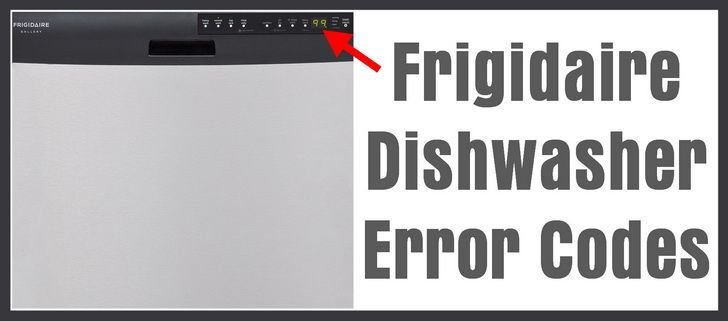
Error codes in appliances are like secret messages from our machines, trying to tell us what’s wrong. The E3 error specifically signals a heating problem in your Frigidaire dishwasher. Essentially, your appliance is having trouble heating up the water, which is crucial for getting those dishes sparkling clean. But don’t worry, just like rebooting your computer can solve many tech problems, resetting your dishwasher might just be the solution here. However, it’s not always that straightforward, and understanding exactly why your dishwasher is misbehaving can go a long way in effectively addressing the issue.
Understanding the E3 Error Code
So, what exactly is the E3 error code trying to communicate? In simple terms, this code indicates that there is a failure within the heating mechanism of your Frigidaire dishwasher. Think of it like trying to take a warm shower, only to find out that your water heater isn’t working. Without the right temperature, your dishwasher can’t perform effectively, because hot water is essential for breaking down and dissolving food particles and grease.
You might wonder, why does this happen in the first place? There are a few common causes. Sometimes it’s due to a faulty heating element, which is like the small but mighty heart of your dishwasher’s heating system. Other times, it could be an issue with the thermostat or the control board, which manages the cycle temperatures. Even a kinked water line could cause issues with water flow and pressure, resulting in the dreaded error code. All of these components play a critical role in ensuring hot water is available to clean your dishes effectively.
Fortunately, these problems can often be diagnosed without needing to call in a professional right away. Understanding what each part does can help you identify whether a simple reset will suffice or if a more in-depth inspection is needed. Just like troubleshooting a stubborn car engine, knowledge is power, and knowing how your dishwasher ticks can be quite empowering.
Will Resetting Solve the Problem?
Now that you know what’s behind the E3 error code, let’s tackle the million-dollar question: will hitting the reset button really solve the issue? The short answer is, it depends. Sometimes, the appliance’s computer just encounters a minor hiccup and a simple reset might do the trick. In the same way that restarting a sluggish computer can solve many issues, resetting your dishwasher can sometimes clear any temporary glitches.
To try resetting your dishwasher, you can usually press and hold the cancel or reset button for a few seconds. This action can sometimes force a hard reset and return everything to normal working order. If your appliance doesn’t have a specific reset button, you might need to use the breaker box to cut power to the dishwasher momentarily, effectively rebooting it. Once complete, turn it back on and see if the error persists.
However, if resetting doesn’t fix the problem, it might mean there’s a deeper issue at play. Regular resets won’t fix a broken heating element or a faulty thermostat. If the error code keeps recurring, it might be time to roll up your sleeves or call in a professional. Sometimes, applying temporary fixes to a deeper problem is like putting a band-aid on a leaky pipe—it might hold for a while, but it won’t solve the root problem.
What to Do If Resetting Doesn’t Work
If resetting your dishwasher doesn’t get rid of the E3 error code, it’s time to dig a little deeper. The next step is to check whether the heating element needs replacing. Similar to swapping out an old light bulb, replacing a faulty heating element requires a bit of technical know-how but can often be done with a guide or manual. You’ll need to access the element, usually located at the bottom of the dishwasher, and test it for continuity using a multimeter.
Alternatively, if the heating element seems fine, the thermostat could be the culprit. The thermostat regulates the temperature and ensures everything runs hot enough to clean effectively. Like a broken thermostat in a car causing overheating or overcooling, a faulty one in your dishwasher needs fixing for optimal performance.
Finally, consider the potential of a malfunctioning control board. This component is akin to the brain of your dishwasher, instructing it when and how to heat the water. If it’s not working properly, it’s best to consult a specialist or a technician who can diagnose and repair the control board.
Preventing Future Issues
Nobody wants to keep facing the same dishwasher woes, so how can you prevent error codes like E3 from recurring? For starters, regular maintenance goes a long way—think of it like regular exercise for your body. Start with monthly checks to ensure that all parts are functioning correctly and that no small issues are being overlooked.
Keep an eye on the filters, ensuring they are clean and clear of debris, which can help prevent clogs and ensure the smooth flow of water. Regularly inspect the hoses for any signs of wear and tear, and replace them as needed. Think of these hoses as the lifelines of your dishwasher—keeping them healthy keeps your dishwasher running smoothly.
In addition, avoid overloading your appliance, as this can strain the heating element and other parts. Proper use and gentle handling are key to prolonging the life of any appliance. By following these preventative care steps, you can minimize the chance of encountering the E3 code (or any code) in the future.
In conclusion, while resetting your Frigidaire dishwasher can sometimes solve the E3 error code, it’s also wise to understand the underlying cause to ensure a long-term solution. Taking care of your dishwasher with regular maintenance can prevent future issues and keep your kitchen running smoothly. So next time the E3 error flashes at you, you’ll know exactly what to do—no more mystery, just dishes as clean as a whistle!